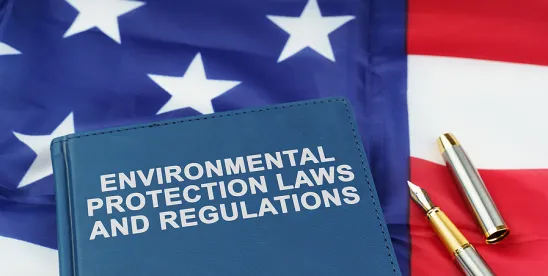On April 22, the Trump Administration issued an Executive Order (EO) directing the US Department of Justice (DOJ) to begin to unwind “disparate impact” regulations that were established under federal civil rights laws. In the environmental context, the EO likely represents the functional end of some Biden Administration environmental justice (EJ) efforts.
While the EO “Restoring Equality of Opportunity and Meritocracy” is mainly targeted at employment law, it explicitly rescinds specific DOJ “Title VI” regulations used in the EJ space. Additionally, citing to “limited enforcement resources of executive departments and agencies [and] the unlawfulness of disparate-impact liability,” federal agencies are directed to “deprioritize enforcement of all statutes and regulations to the extent they include disparate-impact liability.”
What Is EJ?
Title VI of the Civil Rights Act of 1964 requires that “No person in the United States shall, on the ground of race, color, or national origin, be excluded from participation in, be denied the benefits of, or be subjected to discrimination under any program or activity receiving Federal financial assistance.”
In the United States, environmental and public health measures often correlate to variables like education, income, and a community’s racial makeup. In the five decades since US Congress began to create comprehensive environmental statutes like the Clean Air Act, Clean Water Act, and Comprehensive Environmental Response, Compensation, and Liability Act, there has been much success in improving environmental conditions in some communities, but not others.
Prior to the inauguration, the US Environmental Protection Agency (EPA) defined “environmental justice” as “the fair treatment and meaningful involvement of all people regardless of race, color, national origin, or income with respect to the development, implementation and enforcement of environmental laws, regulations and policies.”
Biden Administration EJ Efforts Relying on Title VI
The Biden Administration’s EJ policy focused on improving environmental conditions in “environmentally overburdened” communities. Two examples:
- Early in the Biden Administration, EPA issued a letter outlining preliminary findings that Louisiana regulators’ “actions or inactions have resulted and continue to result in disparate impacts on Black residents” at three Louisiana locations. (For more, see here.) The letter relied on Title VI of the Civil Rights Act of 1964 — the statutory law cited in the EO — and related EPA nondiscrimination regulations which apply to entities receiving federal funding. The letter noted that even though the involved facilities appeared to be operating within permitted limits, further evaluation appeared warranted to ensure there were no adverse impacts in surrounding environmentally overburdened communities. EPA’s investigation was dropped when Louisiana pressed EPA to defend the investigation’s legal basis. A federal district court ultimately enjoined EPA from enforcing disparate impact-based requirements against Louisiana. (See discussion here.)
- In Chicago, Illinois, federal regulators issued a civil-rights focused finding related to the relocation of a metal recycling facility from a wealthy, largely white neighborhood, to a poor diverse one. (For more see here.) The finding put at risk approximately $375 million per year in housing funds Chicago received from the federal government. While Chicago originally contested the finding, a settlement was eventually reached under which Chicago agreed to develop a cumulative impact assessment process. (For more see here.) Chicago’s cumulative impacts ordinance has not yet been finalized.
Importantly, the Biden Administration EPA was often cautious in relying too heavily on federal civil rights laws. For instance, EPA tailored EJ efforts to deemphasize race as a criteria determining whether a particular community was overburdened. EPA’s mapping and demographics tool, EJScreen, originally explicitly analyzed the percentage of people of color in an affected area, but EPA later revised it to deemphasize race as a factor driving EJ actions. (See our past discussion here.) Instead of race, the revised tool used factors like income, education, and population density to identify environmentally overburdened areas. Similarly, when EPA released its Cumulative Impacts Addendum in January 2023 to its memorandum on Legal Tools to Advance Environmental Justice, it said that program staff should confer with the agency’s attorneys on “interpretive issues” and “consideration of other legal issues,” who presumably would weigh in on whether any benefits to a particular community were worth potentially programmatic risk to EPA as a whole.
In contrast, the Trump Administration has essentially disavowed the Biden Administration’s approach to EJ. In its March “Greatest Deregulation in History,” EPA announced that it would “terminate” EPA’s EJ arm. (For more, see here.) This built upon prior efforts. Trump’s first-week EOs revoked several Biden-era policies and announced an effort to terminate all EJ and diversity, equity, and inclusion offices and positions. (For more, see here.)
What to Watch
- Deprioritizing EJ does not mean no enforcement in “overburdened” communities. While addressing EJ issues per se are not on the Trump Administration’s agenda, at least some efforts to address problems in environmentally overburdened communities will continue. As one example, EPA Administrator Lee Zeldin visited East Palestine, Ohio — an environmentally overburdened community and the site of a recent train derailment and chemical spill — shortly after his confirmation accompanied by the vice president.
- Challenges to the EO and state EJ programs may invoke recent US Supreme Court precedent, including the Students for Fair Admissions affirmative action decision. While the federal government deprioritizes EJ as such, many states maintain EJ programs. For example, efforts continue in states as diverse as New York, in which EJ efforts are rooted in recent state statutory changes, and in Louisiana, where they stem from the state constitution. (For more see here.) The EO instructs the Attorney General to determine whether federal law preempts state disparate-impact programs. The Attorney General, or private parties, may file lawsuits against these programs. In such challenges, parties may raise the 2023 Students for Fair Admissions decision (available here), which struck down affirmative action programs at Harvard College and the University of North Carolina on the grounds that these programs violated the Equal Protection Clause of the 14th Amendment. In a concurrence, Justice Neil Gorsuch discussed Title VI and noted that “discrimination” as defined in the statute, “means any disparate treatment amongst individuals on either an individual or aggregate level” and that this “discrimination” is impermissible “without regard to any other reason or motive ….” The Trump Administration may also invoke Students for Fair Admission to defend the EO from possible legal challenge.
- Some litigation in this space is wholly separate from regulations addressed in the EO. State zoning laws are often the unseen hand pushing industrial activities to continue to locate in the same communities, which in turn, are environmentally overburdened. Parties other than federal regulators use litigation to address this. This month, inInclusive Louisiana v. St. James Parish, the Fifth Circuit appellate court overturned a district court decision dismissing one such case filed by residents of St. James Parish, Louisiana, seeking a moratorium on further expansion of petrochemical facilities, and thus allowing the litigation to proceed. (See here for case background.)





 />i
/>i

